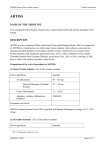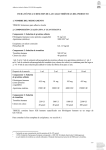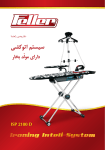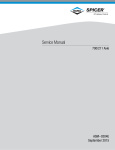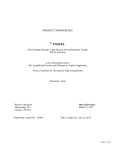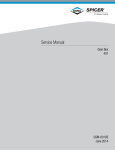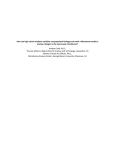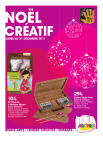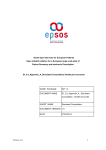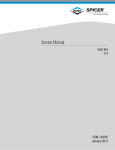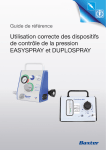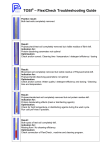Download ARTISS
Transcript
ARTISS (frozen, fibrin sealant syringe) Product Information ARTISS NAME OF THE MEDICINE Two-Component Fibrin Sealant, Deep-Frozen, Vapour Heated (VH) and Solvent Detergent (S/D) treated. DESCRIPTION ARTISS is a two-component fibrin sealant made from pooled human plasma. The two components of ARTISS are formulated as two sterile, deep-frozen solutions. Each solution is presented in a separate preloaded chamber of one double-chamber syringe: chamber one [1] contains Sealer Protein Solution (with Aprotinin), deep frozen (1mL, 2mL or 5mL), chamber two [2] contains Thrombin Solution (with Calcium Chloride), deep frozen (1mL, 2mL or 5mL), resulting in 2mL, 4mL or 10mL total volume of product ready for use. Composition of the Active Ingredients of ARTISS: (1) Sealer Protein Solution 1 mL of the solution contains: Active ingredients As total protein Fibrinogen (Clottable Protein) Factor XIII (human) Aprotinin, synthetic (Fibrinolysis Inhibitor) Excipients (see below) Quantity 96 – 125 mg 72 – 110 mg 1.2 – 10 IU 2250 - 3750 KIU 1 ARTISS contains Human Factor XIII co-purified with Human Fibrinogen in a range of 1.2 - 10.0 IU/mL. (2) Thrombin Solution: 1 mL of the solution contains: Active ingredients Thrombin (human) Calcium Chloride (2 H2O) Excipients (see below) Quantity 3.2 - 5 IU 2 36 - 44 µmol The 2 components of ARTISS are colourless to pale yellow, opalescent when frozen and clear to slightly turbid solutions once defrosted. Composition of the Excipients of ARTISS: (1) Sealer Protein Solution: 1 mL of the solution contains Human Albumin (10-20 mg), Histidine (10-25 mg), Sodium Citrate (4.8-9.7 mg), Polysorbate 80 (0.6–1.9 mg), Nicotinamide (3–9 mg), Water for injection q.s. to 1 mL. (2) Thrombin Solution: 1 mL of the solution contains Human Albumin (45–55 mg), Sodium Chloride (3.5–5.5 mg) and Water for injection q.s to 1 mL. 1 2 KIU = Kallidinogenase Inactivator Unit Thrombin activity is calculated using the current WHO International Standard for thrombin. Page 1 of 14 ARTISS (frozen, fibrin sealant syringe) Product Information Chemical structures The major component of the clottable protein (human origin) is fibrinogen. The fibrinogen molecule is a dimer composed of two symmetrical subunits linked by -S-S- bonds. It could be written in a simple formula as (Aα, Bβ, γ)2 and has a molecular weight (MW) of about 340 000. The Aα-chain contains 610 amino acids (MW about 68 000), the Bβ-chain 461 amino acids (MW about 57 000), and the γ-chain 411 amino acids (MW about 47 000). Thus, the entire human fibrinogen contains 2964 amino acids. Thrombin (human origin) is a glycosylated protein, consisting of two polypeptide subunits A and B, covalently linked by one -S-S- bond. The molecular weight is about 33 800. The human thrombin subunit A chain is made of 36 amino acids, whilst the B chain contains 259 amino acids. Factor XIII (human origin), also called blood-coagulation factor XIII, is a tetramer composed of two a-chains and two b-chains (each of a molecular weight of about 80 000) which are noncovalently associated. Aprotinin (synthetic origin) is a protease inhibitor, a polypeptide consisting of one chain of 58 amino acids with a molecular weight of 6511.5, also stabilised by -S-S- bonds. PHARMACOLOGY Pharmacotherapeutic group: local haemostatics, ATC code: B02BC; tissue adhesives, ATC code: V03AK Pharmacodynamics ARTISS contains two components, Sealer Protein Solution and Thrombin Solution. The Sealer Protein Solution contains fibrinogen as the main active ingredient, and the active ingredient of the Thrombin Solution is human thrombin. These mimic the final step of the coagulation cascade. The thrombin converts fibrinogen to fibrin which then polymerises and is crosslinked by factor XIIIa to form a clot. Due to the low concentration of thrombin in ARTISS, clotting takes about a minute. Clotting causes tissues to adhere and provides a matrix for the in-growth of fibroblasts and capillaries which helps vascularisation and wound healing. The matrix is eventually broken down and absorbed in a process called fibrinolysis. Aprotinin in ARTISS delays fibrinolysis. The following diagram illustrates the conversion of fibrinogen to fibrin, and polymerization. Sealer Protein Solution (Fibrinogen and Aprotinin 3000 KIU/mL) Thrombin Solution 4 (4 IU Thrombin/mL with calcium chloride 40 µmol/mL) Sealer Protein-Thrombin Solution Solidified Fibrin Sealant ARTISS containing 4 IU thrombin has demonstrated adhesion of autologous split skin grafts to surgically prepared wound beds in a pig model. Page 2 of 14 ARTISS (frozen, fibrin sealant syringe) Product Information Pharmacokinetics ARTISS is intended for epilesional use only. Intravascular administration is contraindicated. As a consequence, intravascular pharmacokinetic studies were not performed in man. Fibrin sealants/haemostatics are metabolised in the same way as endogenous fibrin by fibrinolysis and phagocytosis. CLINICAL TRIALS Burns (grafts) ARTISS (frozen) was investigated for fixation of split thickness sheet skin grafts in burn patients in a prospective, randomised, controlled, multicentre clinical study, conducted in 138 burn subjects. In each subject, two comparable test sites were identified. In one test site the skin graft was fixed with ARTISS; in the other test site the graft was fixed with staples (control). The intent-to-treat (ITT) population reported in the study report included 127 of the treated subjects. The 11 treated subjects not included in the study ITT population were excluded for one of the following reasons: no primary endpoint assessment at both test sites (one subject); lost to follow-up prior to Day 28; or photographs not taken at both test sites on Day 28. The median age of subjects was 31 years, range 1-62 years. 14% were ≤6 years of age and 15% 7-18 years of age. 66% of the subjects were male. Similar areas were treated at the two sites: 1.7 ± 0.8% body surface area at ARTISS sites and 1.7 ± 0.7% body surface area at stapled sites. Burn thickness was full in 77% of subjects and partial in 23%. The most commonly grafted sites were the lower arms and lower legs. ARTISS proved to be non-inferior to staples with respect to the primary efficacy endpoint, complete wound closure at Day 28 using a one-sided 97.5% confidence interval on the difference in the proportion of test sites successfully treated. Wound closure was evaluated by a blinded evaluator panel from Day 28 photographs. Results for wound closure on Day 28 are given in Table 1 below: Table 1: Test Sites with Complete Wound Closure on Day 28 ARTISS Staples (control) Difference [95% CI] Difference [97.5% CI]1 Modified Intent to Treat Analysis 55 of 127 (43.3%) 47 of 127 (37.0%) 6.3% [-2.9%, 15.5%] 6.3% [-2.9%, -] Per Protocol Analysis 48 of 106 (45.3%) 42 of 106 (39.6%) 5.7% 5.7% [-4.1%, -] 1 The non-inferiority criterion was a lower limit of the 97.5% confidence interval of the difference between treatments >-10%. There was support from the secondary endpoints which were evaluated by the investigator (Table 2). Page 3 of 14 ARTISS (frozen, fibrin sealant syringe) Product Information Table 2: Summary of Secondary Efficacy Endpoints – Categorical Variables / Intent-toTreat Difference [95% CI] ARTISS Staples [n of N (%)] [n of N (%)] Presence of Haematoma/seroma on Day 1 41 of 138 (29.7%) 86 of 138 (62.3%) -32.6% [-41.4%, -23.8%] 100% Engraftment on Day 5 86 of 138 (62.3%) 76 of 138 (55.1%) 7.2% [-0.2%, 14.7%] Complete Wound Closure on Day 14 63 of 129 (48.8%) 55 of 129 (42.6%) 6.2% [-2.6%, 15.0%] Facial Rhytidectomy (flaps) ARTISS was investigated for adherence of skin flaps in facial rhytidectomy surgeries during two prospective, randomised, controlled, multicenter clinical studies. Both studies had a split-face design in which one side of the face was treated with ARTISS and the other side received standard of care (SoC); therefore each subject participated in both arms (ARTISS and SoC). In the Phase 2 study, ecchymosis evaluation was performed by an independent panel of 5 blinded reviewers. In both the Phase 2 and Phase 3 studies, a standardised drain was placed in each side of the face prior to the flap closure and drainage volume from both sides of the face from all subjects was used to compare adherence. Pressure dressings were not permitted. The combined study population consisted of 120 subjects of which 113 (94.2%) were female and 7 (5.8%) were male. The mean ± SD age was 54.7 ± 7.2 years (range: 40 - 71 years). The mean ± SD weight was 66.5 ± 11.9kg. By race, 116 (96.7%) were white, 2 (1.7%) were black, 1 (0.8%) was Asian, and 1 (0.8%) was of multi race. Ethnicity was Hispanic or Latino in 5 (4.2%) subjects. Overall, the demographic and baseline characteristics were similar for both studies, allowing comparison of appropriate efficacy outcomes. The endpoints analysed for the two studies are: - Drainage volumes at 24 h post operatively, for each side of the face (presented in Table 3) - Occurrence of haematoma and seroma (presented in Table 4) Table 3 Drainage Volume Comparison at 24 h Post Operative Mean ± SD Drainage Mean ± SD Drainage Clinical Study (mL) (mL) ARTISS Side of the Face SoC Side of the Face Phase 2 11.5 ± 13.7 26.8 ± 24.0 45 subjects Phase 3 7.7 ± 7.4 20.0 ± 11.3 75 subjects p-Value < 0.0001 < 0.0001 An integrated analysis of the occurrence of haematoma/seroma in all 120 subjects across two studies was performed. A comparison was made of the proportion of subjects experiencing a Page 4 of 14 ARTISS (frozen, fibrin sealant syringe) Product Information haematoma/seroma exclusively on the ARTISS-treated side or on the SoC side of the face. The difference was statistically significant with 95% CI = 0.035 – 0.172, p <0.05. Table 4 Occurrence of Haematoma / Seroma ARTISS SoC Both Sides of Face n (%) n (%) n (%) Total n (%) 2 (1.7%) 19 (15.8%) 14 (11.7%) 3 (2.5%) INDICATIONS • ARTISS is indicated to adhere autologous skin grafts in burn patients. • ARTISS is indicated to adhere tissue flaps during facial rhytidectomy surgery (face-lift). • ARTISS is not indicated for haemostasis. CONTRAINDICATIONS Known hypersensitivity to aprotinin or known hypersensitivity to any other component of ARTISS. Injection of ARTISS into tissues is contraindicated. Such use has been associated with inadvertent intravascular injection, with thromboembolic complications. ARTISS should be applied with caution to minimise any risk of intravascular application. ARTISS should only be applied topically. Additionally, soft tissue injection of ARTISS carries the risk of an anaphylactic reaction and/or local tissue damage. PRECAUTIONS Viral and Prion Risk Sealer Protein Solution and Thrombin Solution are made from human plasma. Products made from human plasma may contain infectious agents which can cause disease, such as viruses and theoretically, the agent that causes Creutzfeldt-Jakob Disease (CJD) in humans. Standard measures to prevent infections resulting from the use of medicinal products prepared from human blood or plasma include selection of donors, screening of individual donations and plasma pools for specific markers of infection and the inclusion of effective manufacturing steps for the inactivation/removal of viruses. Despite this, when medicinal products prepared from human blood or plasma are administered, the possibility of transmitting infective agents cannot be totally excluded. This also applies to unknown or emerging viruses or other pathogens. The measures taken are considered effective for inactivation/removal of enveloped viruses such as HIV, HBV, and HCV, and for the non-enveloped virus HAV. The measures taken may be of limited value against small non-enveloped viruses such as parvovirus B19. Parvovirus B19 infection may be serious for pregnant women (foetal infection) and for individuals with immunodeficiency or increased red blood cell turnover (e.g., haemolytic anaemia). All infections thought by a clinician possibly to have been transmitted by ARTISS should be reported by the clinician or other healthcare provider to Baxter. Page 5 of 14 ARTISS (frozen, fibrin sealant syringe) Product Information Patients should be instructed to consult their clinician if symptoms of B19 virus infection appear (fever, drowsiness, chills and runny nose, followed about two weeks later by a rash and joint pain). General Administration of ARTISS may result in allergic reactions in some patients. For patients with a known allergic diathesis, a history of hypersensitivity to medical products or a history of having previously received aprotinin-containing products (including previous use of ARTISS) a careful risk-benefit assessment should be carried out prior to administration. The risk of immunisation against proteins such as aprotinin is increased if repeated exposure occurs within six months. If it is decided to proceed with treatment in such patients, prior administration of antihistamines should be considered. Manifestations of hypersensitivity reactions to ARTISS observed include: bradycardia, tachycardia, hypotension, flushing, bronchospasm, wheezing, dyspnoea, nausea, urticaria, angioedema, pruritus, erythema, paraesthesia. Fatal anaphylactic reactions, including anaphylactic shock, have also been reported with ARTISS. Refer ADVERSE EFFECTS. Intravascular application might increase the likelihood and severity of acute hypersensitivity reactions in susceptible patients. Because of the risk of intravascular injection, the product must not be injected into highly vascularised tissue, such as nasal mucosa. ARTISS contains synthetic aprotinin. As synthetic aprotinin is structurally identical to bovine aprotinin, the use of ARTISS in patients with allergies to bovine proteins should be carefully evaluated. Air or gas embolism, tissue rupture, or gas entrapment with compression, which may be lifethreatening, have occurred with the use of spray devices employing a pressure regulator to administer ARTISS. These events appear to be related to the use of the spray device at higher than recommended pressures and in close proximity to the tissue surface. To reduce the risk of a potentially life-threatening gas embolism, when applying ARTISS using a spray device, be sure to use the pressure within the pressure range recommend by the spray device manufacturer. In the absence of a specific recommendation avoid using pressure above 1.4-1.7 bars (20 – 25 psi). Do not spray if the distance is closer than the distance recommended by the spray device manufacturer. In the absence of a specific recommendation avoid spraying closer than 10-15 cm from the surface of the tissue. When spraying ARTISS, changes in blood pressure, pulse, oxygen saturation and end tidal CO2 should be monitored because of the possibility of occurrence of air or gas embolism. As the Sealer Protein and Thrombin Solutions can be denatured following contact with solutions containing alcohol, iodine or heavy metals (e.g. in disinfectants), any such substances should be removed before application. Refer to Incompatibilities. If possible, cover all tissue adjacent to the site of sealing before applying ARTISS. Apply ARTISS in a thin layer. Excessive clot thickness may interfere with the product’s efficacy and the wound healing process. Effects on fertility Studies of the effect of ARTISS on fertility have not been performed. Page 6 of 14 ARTISS (frozen, fibrin sealant syringe) Product Information Use in pregnancy - Category B2 The safety of ARTISS for use in human pregnancy has not been established in controlled clinical studies. Animal studies have also not been performed. Physicians should carefully consider the potential risks and benefits for each patient before prescribing ARTISS. Therefore, the product should be administered to pregnant women only if clearly needed. See PRECAUTIONS (Viral and Prion Risk) for information on Parvovirus B19 infection. Use in lactation The safety of ARTISS for use in breastfeeding has not been established in controlled clinical studies. Animal studies have also not been performed. Physicians should carefully consider the potential risks and benefits for each patient before prescribing ARTISS. Therefore, the product should be administered to lactating women only if clearly needed. Paediatric use In the burns setting, efficacy and safety in the paediatric population was not different from the adult population. Use in the elderly Thirteen subjects aged 65 and older (40 – 71 years of age) have been treated with ARTISS in facial rhytidectomy clinical studies. Separate evaluations of these subjects were not performed. Genotoxicity Studies of genotoxic potential of ARTISS have not been performed. Carcinogenicity Animal studies to evaluate the carcinogenic potential of ARTISS have not been performed. INTERACTIONS WITH OTHER MEDICINES No interaction studies have been performed with ARTISS. No known interactions based upon the absence of data from clinical trials, current medical/scientific literature, and post marketing safety reports. Refer to Incompatibilities for more detailed information on interactions with substances other than drugs. ADVERSE EFFECTS Adverse Reactions from Clinical Trials In a phase 3, multi-centred, prospective, evaluator-blinded, randomised study, where ARTISS was used to affix split thickness sheet skin grafts to excised burn wounds, a total of 8 non-serious adverse reactions were reported. There were no serious reactions. The eight non-serious adverse reactions occurred in six patients. Five of these reactions were skin graft failures, 4 were graft detachment/non-adherence, and 1 was graft necrosis. The remaining non serious adverse reactions were pruritus (2) and dermal cyst (1). Page 7 of 14 ARTISS (frozen, fibrin sealant syringe) Table 5: Clinical Trial Adverse Reactions System Organ Class (SOC) SKIN AND SUBCUTANEOUS TISSUE DISORDERS INJURY POISONING AND PROCEDURAL COMPLICATIONS Product Information Preferred MedDRA Term Dermal cyst Pruritus Skin graft failure Frequency Uncommon Common Common Frequency Ratio 1/138 2/138 5/138 Legend: ADR frequency is based upon the following scale: very common (≥1/10), common (≥1/100 to <1/10), uncommon (≥1/1,000 to <1/100), rare (≥1/10,000 to <1/1,000), very rare (<1/10,000). There were no reports of serious, associated adverse reactions reported above 1% in the facial rhytidectomy clinical studies. Post marketing Adverse Reactions There are limited post-marketing data availale for ARTISS. Because these reactions are reported voluntarily from a population of uncertain size, it is not always possible to reliably estimate the frequency or establish a causal relationship to drug exposure. Adverse reactions reported from clinical studies as well as from post-marketing surveillance of Baxter´s other fibrin sealants are summarised in the following. Unknown frequencies are based on spontaneous reports from post-marketing surveillance of Baxter’s fibrin sealants. Immune system disorders: Frequency unknown: Hypersensitivity reactions (including anaphylactic reactions, anaphylactic shock, and the following manifestations: angioedema, paraesthesia, bradycardia, tachycardia, flushing, bronchospasm, dyspnoea, wheezing, urticaria, pruritus, and erythema). Anaphylactic reactions and anaphylactic shock have included fatal outcomes. Cardiac disorders: Frequency unknown: bradycardia, tachycardia Vascular disorders: Frequency unknown: hypotension, haematoma and air embolism* *Air embolism associated with misapplication of fibrin sealant using a spray device: There are reports of life threatening/fatal air or gas embolism associated with the use of fibrin sealants when applied using a spray device at higher than the recommended pressure and closer than the recommended distance in an attempt to stop active bleeding. Respiratory, thoracic and mediastinal disorders: Frequency unknown: dyspnoea Gastrointestinal disorders: Frequency unknown: nausea Skin and subcutaneous tissue disorders: Common: pruritus Uncommon: dermal cyst Frequency unknown: urticaria General disorders and administration site conditions: Frequency unknown: flushing, impaired healing, oedema, pyrexia Page 8 of 14 ARTISS (frozen, fibrin sealant syringe) Product Information Injury, poisoning and procedural complication: Common: skin graft failure Frequency unknown: seroma Class Reactions Manifestations of hypersensitivity or allergic reactions associated with the class of fibrin sealant/haemostatic products include: application site irritation, chest discomfort, chills, headache, lethargy, restlessness and vomiting. There have been no reports of these reactions related to the specific use of ARTISS. DOSAGE AND ADMINISTRATION ARTISS should be administered topically. Do not inject. Dry the site of application. Prior to applying ARTISS, the surface area of the wound needs to be dried using standard techniques (eg intermittent application of compresses, swabs, use of suction devices). Do not use pressurised air or gas for drying the site ARTISS should be used by physicians who have been educated on or trained in the use of ARTISS. Application of the product must be individualised to the patient by the treating physician. It is recommended that the initial application cover the entire intended application area. Repeat application may be necessary, for example, to cover a gap in an ARTISS layer after initial application. In such a case, re-application of ARTISS should be limited to the area of the gap itself. Application beyond the gap should be avoided as a new layer of ARTISS may not adhere firmly to a layer of already polymerized ARTISS from the initial applicaton. The skin graft should be attached to the wound bed immediately after ARTISS has been applied. The surgeon has up to 60 seconds to manipulate and position the graft prior to polymerization. After the flap or graft has been positioned, hold in the desired position by gentle compression for at least 3 minutes to ensure ARTISS sets properly and the graft or flap adheres firmly to the underlying tissue. It is strongly recommended that every time a patient receives a dose of ARTISS, the name and batch number of the product are recorded in order to maintain a record of the batches used. Cannula The cannulas included with the DUPLOJECT Preparation and Application System or DUO Set may be used for small wounds or for edges of a skin graft that did not adhere to the wound bed. Immediately before application, expel and discard the first several drops from the application cannula to ensure adequate mixing of the sealer protein and thrombin solutions. The wound surface should be as dry as possible before application of ARTISS. Apply ARTISS thinly (2 mL/100 cm2) to avoid formation of excessive granulation tissue and interference with wound healing. If application is interrupted, clogging will occur quickly in the cannula. Replace the application cannula with a new one only immediately before application is resumed. If the aperture of the joining piece (Y connector) facing the cannula is clogged, use the spare joining piece provided in the package. Page 9 of 14 ARTISS (frozen, fibrin sealant syringe) Product Information Spray Set For large surface areas, spray application is recommended. The required dose of ARTISS depends on the size of the surface to be covered. The approximate surface areas covered by each package size of ARTISS by spray application are: Approximate area requiring tissue adherence 100 cm² 200 cm² 500 cm² Required package size of ARTISS 2 mL 4 mL 10 mL This recommended dose applies to all age groups. Method of Preparation of ARTISS Preloaded Syringe (Frozen) • Unopened pouches, thawed at room temperature, may be stored for up to 14 days at controlled room temperature (not exceeding + 25°C). If not used within 14 days after thawing, ARTISS must be discarded. • To facilitate optimal blending of the two solutions, the two sealant components must be warmed to 33-37°C immediately before use. • ARTISS must not be exposed to temperatures above 37°C and must not be microwaved. • After quick thawing (i.e. thawing at a temperature of 33-37°C) ARTISS may be stored at 3337°C for a maximum of 4 hours. • To prevent ARTISS from adhering, wet gloves and instruments with sodium chloride solution before contact. • Do not use ARTISS unless it is completely thawed and warmed (liquid consistency). The protective syringe cap should not be removed until storage, thawing and warming is complete and application tip is ready to be attached. For quick thawing of the preloaded syringe use one of the three following options: Option 1 – Thawing on the sterile field 33°C to 37°C sterile water bath: – transfer devices set and the inner pouch to the sterile field, remove devices set with preloaded syringes from inner pouch and place directly into sterile water bath. Ensure the contents of the syringe are completely immersed under the water. Approximate thawing and warming times when using this method are: Pack Size 2 mL 4 mL 10 mL Thawing/Warming Times 33°C to 37°C Sterile Water Bath (Pouches Removed) 5 minutes 5 minutes 12 minutes Option 2 – Thawing off the sterile field using water bath 33°C to 37°C non-sterile water bath in two pouches: – maintain the devices set in both pouches and place into a water bath off the sterile field for appropriate time. Ensure the pouches remain submerged throughout thawing. Remove from the water bath after thawing, dry external pouch and transfer inner pouch and preloaded syringe onto the sterile field. Approximate thawing and warming times when using this method are: Page 10 of 14 ARTISS (frozen, fibrin sealant syringe) Pack Size 2 mL 4 mL 10 mL Product Information Thawing/Warming Times 33°C to 37°C Non-Sterile Water Bath (In Pouches) 30 minutes 40 minutes 80 minutes Option 3 – Thawing off the sterile field using incubator Incubator (33°C to 37°C) in pouches: – maintain the devices set in both pouches and place into an incubator for appropriate time. Remove from incubator after thawing and transfer inner pouch and preloaded syringe onto the sterile field. Approximate thawing and warming times when using this method are: Pack Size 2 mL 4 mL 10 mL Thawing/Warming Times 33°C to 37°C Incubator (In Pouches) 40 minutes 85 minutes 105 minutes Operating Instructions Cannula For application, the double-chamber syringe with the Sealer Protein Solution and the Thrombin Solution has to be connected to a joining piece and an application cannula as provided in the accompanying set of devices. The common plunger of the double-chamber syringe ensures that equal volumes are fed through the joining piece before being mixed in the application cannula and ejected. Device Set Instructions: firmly connect the double chamber syringe nozzles to the Y–piece and secure it by fastening the tether strap to the syringe. Fit an application cannula onto the Y-piece. To avoid clogging, do not expel the air remaining inside the Y-piece or application cannula until application. Spray Set See package insert of the spray set for instructions on administration of ARTISS using the spray set. Page 11 of 14 ARTISS (frozen, fibrin sealant syringe) Product Information Air embolism has occurred with the use of a spray device to administer fibrin sealant (see ADVERSE EFFECTS). This appears to be related to the use of the spray device at higher than recommended pressures and in close proximity to the tissue surface. Caution must be used when applying fibrin sealant using pressurized air or gas. • • • • • • • • • Any application of pressurized air or gas is associated with a potential risk of air or gas embolism, tissue rupture, or gas entrapment with compression, which may be lifethreatening or fatal. Life threatening/fatal air or gas embolism has occurred with the use of spray devices employing a pressure regulator to administer fibrin sealants. This event appears to be related to the use of the spray device at higher than recommended pressure and/or in close proximity to the tissue surface. The risk appears to be higher when fibrin sealants are sprayed with air, as compared to CO2 and therefore cannot be excluded with ARTISS when sprayed in open wound surgery. ARTISS with the spray set must not be used in enclosed body areas. ARTISS must be sprayed only onto application sites that are visible. ARTISS must not be applied intravascularly. The user must follow the instructions and precautions in the Easy Spray device user manual, for example regarding the need to limit the gas pressure to a maximum of 2 bars and not be sprayed if the distance is closer than 10 cm from the tissue surface. To reduce the risk of a potentially life-threatening gas embolism when applying ARTISS using a spray device, be sure to use a pressure within the pressure range recommended by the spray device manufacturer. ARTISS spray application should only be used if it is possible to accurately judge the spray distance and do not spray if the distance is closer than recommended by the manufacturer. Only use application devices licensed/CE Marked for the administration of ARTISS.. When spraying ARTISS, changes in blood pressure, pulse, oxygen saturation and end tidal CO2 should be monitored because of the possibility of air or gas embolism. Incompatibilities • Solutions containing alcohol, iodine or heavy metals will interfere with the product’s performance due to denaturation of proteins or other mechanisms. If any of these substances have been used to clean the wound area; the area must be thoroughly rinsed and dried before application of ARTISS. • Oxidised cellulose-containing preparations may reduce the efficacy of ARTISS and should not be used as carrier materials. • ARTISS must not be mixed with other medicinal products. OVERDOSAGE To avoid the formation of excess granulation tissue and to ensure gradual absorption of the solidified fibrin sealant, only a thin layer of the mixed Sealer Protein Thrombin Solution or the individual components should be applied. In the event of overdosage, please contact the Poison Information Centre at Phone Number: 131126. Page 12 of 14 ARTISS (frozen, fibrin sealant syringe) Product Information PRESENTATION AND STORAGE CONDITIONS Nature and Contents of Container Nature of containers: Both Sealer Protein Solution and Thrombin Solution are contained in two separate chambers of a single use double chamber syringe made of polypropylene. Contents: Each pack ARTISS contains • One single use double chamber syringe, each chamber containing: - Chamber number [1]:Sealer Protein Solution (with aprotinin) deep frozen - Chamber number [2]: Thrombin Solution (with calcium chloride) deep frozen • One set of devices (see below) ARTISS is available in the following pack sizes: • ARTISS, 2.0 mL (containing 1.0 mL of Sealer Protein Solution and 1.0 mL of Thrombin Solution) • ARTISS, 4.0 mL (containing 2.0 mL of Sealer Protein Solution and 2.0 mL of Thrombin Solution) • ARTISS, 10.0 mL (containing 5.0 mL of Sealer Protein Solution and 5.0 mL of Thrombin Solution) Shelf Life Deep frozen ARTISS has a shelf life of two years at temperatures < -18°C. The expiry date is stated on the final container and the package. Unopened pouches, thawed at room temperature, may be stored for up to 14 days at controlled room temperature (not exceeding + 25°C). If not used within 14 days after thawing, ARTISS must be discarded. After thawing, the solutions must not be refrigerated or refrozen! After quick thawing (i.e. thawing at a temperature of 33-37°C) ARTISS may be stored at 3337°C for a maximum of 4 hours. The ARTISS solutions contain no antimicrobial agent. ARTISS is intended for single use in one patient only and unused solution in the syringe should be discarded. Special Precautions for Storage Store in a freezer (at -18°C or colder). The cold storage chain must not be interrupted until use. Keep container in the outer carton to protect from light. Once thawed, do not refreeze or refrigerate. Keep out of reach and sight of children. For single use only. Do not re-sterilise! Set of Devices Each pack ARTISS contains a double-sterile set of devices (DUO SET) consisting of one syringe double-plunger, two Y-pieces and four application cannulas. These devices are used for the simultaneous application of the fibrin sealant components. For details on application and complications associated therewith see DOSAGE AND ADMINISTRATION – section Operating Instructions. The set of devices is sterile and non-pyrogenic in unopened and undamaged package. Sterilised by exposure to ethylene oxide. Page 13 of 14 ARTISS (frozen, fibrin sealant syringe) Product Information NAME AND ADDRESS OF THE SPONSOR Baxter Healthcare Pty Ltd 1 Baxter Drive, Old Toongabbie, NSW 2146 POISON SCHEDULE OF THE MEDICINE: Unscheduled DATE OF FIRST INCLUSION IN THE AUSTRALIAN REGISTER OF THERAPEUTIC GOODS (THE ARTG): 19 August 2010 DATE OF MOST RECENT AMENDMENT: 20 February 2015 Page 14 of 14














